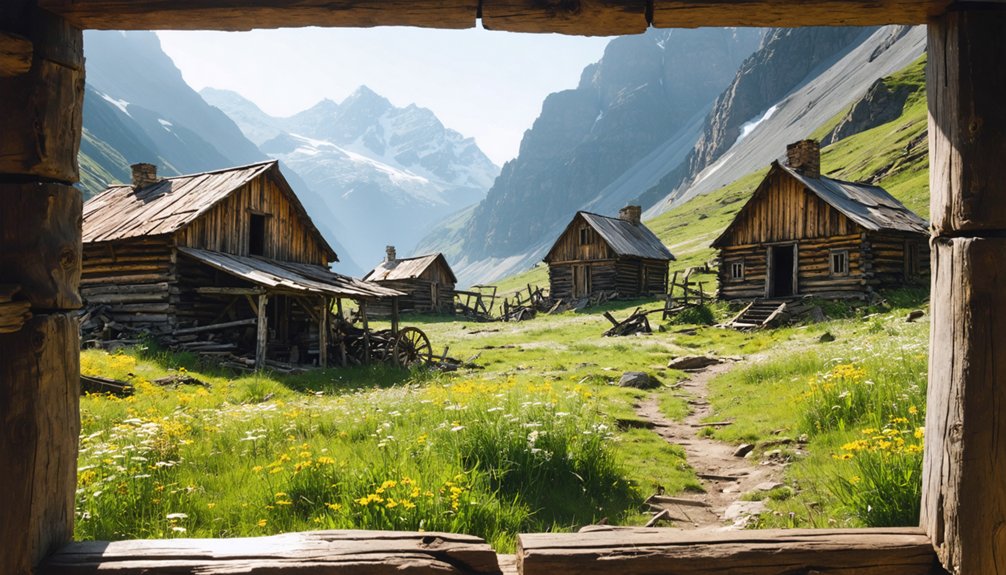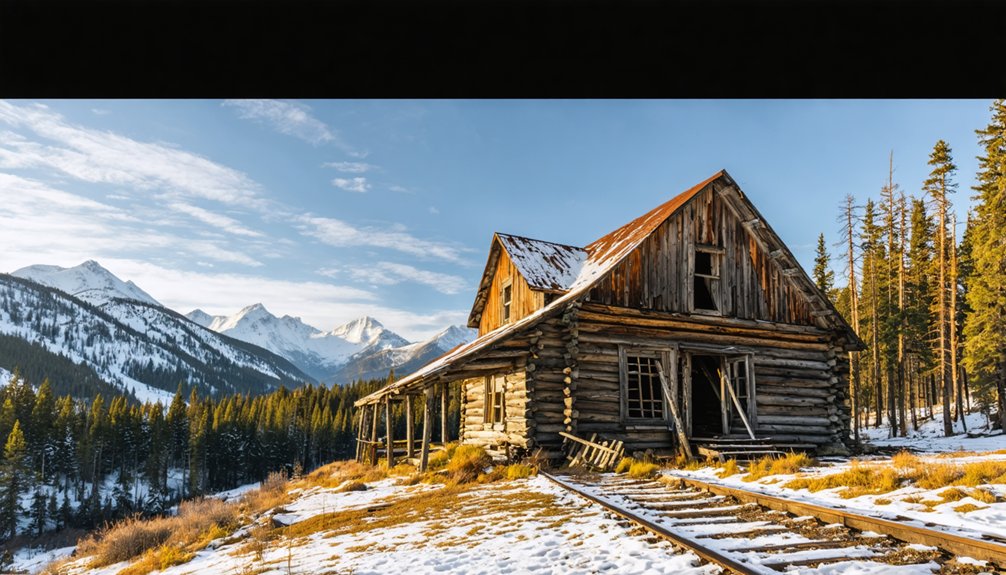When you visit Swandyke, Colorado today, you’ll discover the silent remnants of a once-thriving mining settlement that flourished at 11,000 feet in the late 1890s. After rich lead-silver veins sparked its 1897 founding, the town boasted a 75-person hotel and thrived until surface gold depleted around 1910. The Forest Service intervened in 1973, preserving significant structures while removing unsafe buildings. These weathered foundations tell stories of brief prosperity amid harsh mountain conditions.
Key Takeaways
- Swandyke was established in the 1870s near Colorado’s Swan River as a mining settlement that peaked following an 1899 iron sulfide discovery.
- Located at 11,000 feet elevation, the town faced harsh environmental challenges with winter temperatures reaching -35°F.
- The Royal Tiger Mines Company developed infrastructure including a 75-person hotel before gold depletion caused decline by 1910.
- In 1973, the Forest Service removed unsafe structures while preserving historically significant buildings and implementing ecological restoration efforts.
- Today, Swandyke’s photogenic ruins include structural remains, stone foundations, and weathered cabins within Colorado’s alpine landscape.
The Rise of a Mountain Mining Settlement
As the late nineteenth century ushered in a new era of western expansion, Swandyke emerged along the Middle Fork of the Swan River in Summit County, Colorado, establishing itself as a high-altitude mining settlement near timberline.
You’d find the town’s origins traced to the late 1870s when prospectors discovered lead-silver veins similar to Leadville’s deposits. Though officially founded around 1897, Swandyke’s destiny changed dramatically with an 1899 iron sulfide strike that triggered rapid growth.
Like Leadville before it, Swandyke’s humble silver beginnings yielded to explosive growth following the 1899 iron sulfide discovery.
Mining techniques focused on extracting gold from quartz veins at elevations approaching 13,000 feet—unusually high for such operations. The town benefited from being part of the productive Swan River District, which had seen extensive dredging and placer mining operations along its length.
The settlement’s urban planning accommodated 400-500 residents with essential infrastructure: a 75-guest hotel, post office (established 1898), butcher shop, barbershop, saloon, and blacksmith shop—all serving miners tackling the challenging mountain terrain. The Carrie Mine was particularly significant to Swandyke’s development, having installed an advanced electro-cyanide mill that increased ore processing efficiency.
Life at 11,000 Feet: Daily Existence in Swandyke
Three fundamental realities defined daily life in Swandyke: altitude, isolation, and weather. At 11,000 feet, you’d struggle with thin air while performing routine mining tasks, your body gradually adapting to the oxygen scarcity.
The harsh climate demanded survival strategies that evolved with the seasons. Summer brought brief respite with temperatures reaching 70°F, though nighttime could still plunge below freezing. During this period, Swandyke residents experienced a seasonal cycle with 70-80% of precipitation falling during the growing months. The town’s extreme elevation meant residents experienced temperature decreases with altitude compared to nearby lower settlements.
During winters, you’d face temperatures as low as -35°F, requiring constant vigilance maintaining heat in your dwelling. You’d layer clothing to manage the dramatic daily temperature fluctuations caused by low humidity.
Food preservation became essential as growing seasons were nonexistent, forcing reliance on supplies from lower elevations. Despite these challenges, the tight-knit community shared resources, adapting together to Swandyke’s unforgiving mountain environment.
Gold Rush Operations and Economic Development

When gold was discovered in quartz veins at elevations around 13,000 feet, Swandyke’s transformation from wilderness to mining hub began in earnest.
Miners initially employed placer mining techniques to extract surface gold before advancing to hydraulic methods, using high-pressure hoses to wash down gold-bearing gravel.
You’d have witnessed the Royal Tiger Mines Company leading operations, developing infrastructure that connected Swandyke to the wider mining economy.
The town supported a 75-person hotel while Broncho Dave Braddock’s stage lines transported ore to railheads at Braddocks.
Gold extraction drove every aspect of local development—from cabins and mine shafts to processing facilities.
Like many Colorado mining settlements, Swandyke emerged during the Pikes Peak gold rush that brought over 100,000 prospectors to the region in 1859.
The B&B Mines Company later succeeded Royal Tiger, continuing operations until 2008.
The Wise Mountain cabin, constructed in 1878, stands as a rare surviving structure from Swandyke’s mining heyday.
Meanwhile, the environmental cost mounted: deforestation, mountainside destabilization, and soil erosion eventually contributed to rock slides that buried portions of this once-thriving mining community.
From Prosperity to Decline: The Town’s Evolution
Swandyke’s journey from prosperity to ghost town status unfolded rapidly at the turn of the 20th century, compressed into little more than a decade of boom-and-bust development.
You’d have witnessed the town’s peak in the late 1890s, when the hotel housed 75 guests and mining activity created a bustling atmosphere despite the harsh 11,000-foot alpine environment.
As surface gold deposits depleted by 1910, mining challenges mounted. Extraction became less profitable, and the severe mountain winters tested community resilience. The decline of Swandyke mirrored other communities like Capitol City, which dwindled after silver prices dropped.
Families gradually departed as operations ceased, leaving buildings to deteriorate in the unforgiving climate. Similar to Animas Forks at 11,185 ft elevation, Swandyke struggled with the challenges of high-altitude settlement. The shift from thriving settlement to abandonment happened swiftly—a typical pattern for high-altitude mining towns whose existence depended entirely on resource availability.
What remained were silent structures, mining artifacts, and stories of brief prosperity in Colorado’s rugged mountains.
The 1973 Forest Service Intervention
You’ll discover that by 1973, the Forest Service faced a critical situation as squatters had begun occupying abandoned structures throughout Swandyke.
In response, officials systematically torched unsafe buildings while preserving historically significant structures for future generations. This approach reflected the agency’s difficult balancing of multiple priorities during a period of significant legislative changes. The documentation of these preservation efforts can be found in publications like Ghost Towns of the Colorado Rockies, which details many similar mining settlements.
The agency’s ecological restoration efforts included revegetation of mine tailings and stream rehabilitation, laying groundwork for the ghost town’s current status as a carefully managed historical site.
Squatter Community Formation
As the abandoned structures of Swandyke stood silent against Colorado’s mountainous backdrop, an informal community gradually took shape during the 1960s and early 1970s.
You’d find these pioneers occupying the ghost town’s forgotten buildings as regional economic downturns pushed them toward alternative living arrangements.
This squatter identity emerged organically, with residents establishing themselves without legal recognition or formal approval from authorities.
The community’s resilience grew as enforcement remained relaxed, creating an unofficial settlement within and around the former mining town’s deteriorating infrastructure.
While the Forest Service managed nearby lands, the abandoned town became a haven for those seeking freedom from conventional living.
This delicate arrangement would continue undisturbed until 1973, when significant Forest Service reorganizations and stricter land management policies would challenge their existence.
Torching Abandoned Structures
The summer of 1973 marked a decisive turning point for Swandyke when Forest Service personnel arrived with torches and fire equipment to systematically eliminate what they classified as hazardous structures.
Under the recently enacted Federal Advisory Committee Act, officials deemed the deteriorating buildings unsafe and potential catalysts for wildfires.
You’d have witnessed crews conducting pre-burn assessments before setting controlled fires to collapse the remaining shells of Swandyke’s past.
While justified as necessary for community safety, the operation sparked debates about historical preservation versus hazard mitigation.
Each building burned under strict supervision, with fire teams standing by to prevent spread to surrounding forests.
The intervention cleared dangerous debris and reduced fire risk, but forever altered Swandyke’s physical landscape—setting precedent for how abandoned mining settlements throughout Colorado would be managed for decades to come.
Ecological Restoration Efforts
When Forest Service ecologists arrived in the summer of 1973, they brought more than just torches to Swandyke—they carried detailed ecological restoration plans that would transform the ghost town’s future.
Their intervention, part of a broader national policy, prioritized ecological balance over historic preservation.
You can still see evidence of their systematic approach as you explore the upper sections near Swan River’s headwaters. They removed select structures to reduce fire hazards and eliminate soil contaminants, while allowing others to naturally decay.
Their meticulous documentation tracked which buildings were dismantled and which remained.
The results of this controversial work are visible today. Native plants have reclaimed once-developed areas, and wildlife restoration efforts have succeeded—deer and small mammals now frequent places where miners once lived.
The Middle Fork watershed has gradually returned to its pre-settlement condition.
Exploring Swandyke’s Ruins Today

While you’ll find Swandyke considerably deteriorated from its mining heyday, several photogenic structural remains still stand amid the alpine landscape at 11,076 feet.
You can carefully navigate around fallen timbers of the once-impressive 75-person hotel and examine the weathered cabins that housed miners during the town’s brief 1897-1910 prosperity.
Your exploration requires respect for these fragile historic remnants, which continue to fade through natural processes and occasional human interference despite their significance among Colorado’s 640 visible ghost towns.
Remnants Worth Finding
Nestled between the forks of the Swan River at approximately 11,000 feet elevation, Swandyke’s ghostly remnants offer dedicated explorers a fascinating glimpse into Colorado’s mining past.
You’ll discover foundations of mining structures scattered throughout the site, with the hotel ruins being among the most significant hidden treasures. This once-impressive establishment housed up to 75 people during Swandyke’s heyday.
As you navigate the Georgia Pass road, look for quartz veins at 13,000 feet that reveal the historical significance of the area’s gold mining operations.
Nearby, you’ll find tailings, sluice remnants, and occasionally rusted mining equipment. The cemetery and stone monument marking a former Masonic Temple provide poignant connections to those who once called this mountain town home.
Despite natural reclamation, these weathered artifacts persist as evidence of Colorado’s mining legacy.
Photography Amid Destruction
Photographers seeking to capture Swandyke’s haunting beauty face both extraordinary opportunities and significant challenges amid its weathered ruins. The stone foundations of the once-bustling hotel and scattered cabin remnants provide compelling historical context against dramatic mountain backdrops.
You’ll find the best light during early morning or golden hour, when long shadows accentuate the texture of crumbling structures. Summer brings wildflowers while winter transforms ruins into snow-draped sculptures.
When planning your ruins photography expedition, remember that 4×4 access is essential, and you’ll need to carry all equipment over uneven terrain. Always practice preservation ethics by avoiding climbing on structures or disturbing artifacts.
Maintain awareness of wildlife and changing weather conditions. The cemetery and mining remnants offer particularly poignant subjects that connect viewers to Swandyke’s forgotten story.
Frequently Asked Questions
Who Was the Ohio Boy Who Founded Swandyke?
Incredibly, no specific Ohio boy founded Swandyke! You won’t find this detail in Swandyke history records, as its 1898 establishment doesn’t credit any individual founder from Ohio in preserved accounts.
Were Any Artifacts Recovered Before the 1973 Burning?
You won’t find documented evidence of significant artifacts recovered before the 1973 burning. Historical preservation efforts were minimal, limiting our understanding of artifact significance in this once-thriving mining community.
What Happened to the Residents After the Town Declined?
You’ll find former residents scattered after mining declined, pursuing livelihoods elsewhere. Their migration left no revitalization efforts until hippies briefly inhabited the ruins in the 1970s. The town wasn’t preserved.
Are There Any Confirmed Ghost Stories or Paranormal Reports?
No official records exist of ghost sightings or haunted locations in Swandyke. You’ll find abandoned structures and history to explore, but paranormal activity remains undocumented in this forgotten mining settlement’s preservation records.
Can Visitors Legally Remove or Metal Detect Items From Ruins?
No, you can’t legally remove items or metal detect in ruins. Legal regulations prohibit artifact collection on public lands, while ethical considerations emphasize preservation. Always respect historical sites for future generations to enjoy.
References
- https://en.wikipedia.org/wiki/List_of_ghost_towns_in_Colorado
- https://www.sandradallas.com/colorado-ghost-towns-and-mining
- https://coloradosghosttowns.com/Swandyke Colorado.html
- https://goodtimesadventures.com/history.html
- https://www.onxmaps.com/offroad/trails/us/colorado/north-middle-fork-of-the-swan-river
- https://skjtravel.net/index.php/15-features/471-the-shrinking-past-more-mining-memories-in-colorado
- https://www.phantomranch.net/ghostown/articles/ghosts-of-list.htm
- https://westernmininghistory.com/library/38269/page1/
- https://www.summitdaily.com/news/touring-summit-countys-historic-mine-sites-by-jeep/
- https://www.mindat.org/locentry-661644.html



